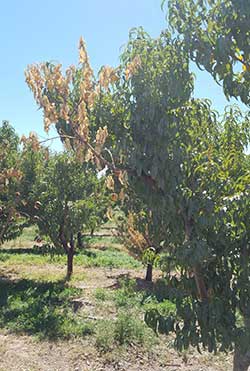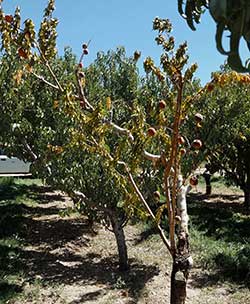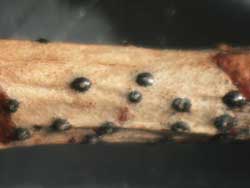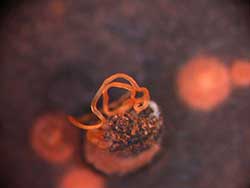by Jane E. Stewart1, Stephan T. Miller1, Ioannis S. Minas2,3 (9/18)
Quick Facts…
- Common Cytospora canker infection sites include pruning cuts and freeze damage wounds.
- Trees should be trained properly to avoid biotic and abiotic damages to tissue which serve as a point of Cytospora leucostoma infection.
- Thiophanate-methyl, captan, and lime sulfur applied as sealant sprays on pruning wounds showed evidence of efficacy as preventive measures to Cytospora leucostoma infections.
- Latex alone and in combination with thiophanatemethyl or captan showed efficacy during summer months, as did lime sulfur combined with kaolin clay.
Peach (Prunus persica) production in Colorado occurs in the western portion of the state, primarily in the Mesa, Delta, Montrose, and Montezuma counties. With high market value, the peach industry is Colorado’s most important fruit crop with a utilized production total of $30 million annually on an estimated 2,500 acres as of 2016 (USDA 2016). However, the geography and environmental conditions of western Colorado can be conducive to high stress conditions for peach tree growth, including spring frosts, alkaline soils, sun scald damage, and water deficit stress all leading to increased incidence of the opportunistic pathogen: Cytospora leucostoma (Sharp et al. 2011), the causal agent of Cytospora canker.
Cytospora Species Reported on Peach
Cytospora species have been reported on at least sixty genera of hardwood and conifer trees and pose a serious threat to tree fruit crops (Grove 1935). In peach production systems, three Cytospora species have been reported as the casual agents of Cytospora canker. Molecular studies show that Cytospora leucostoma (teleomorph: Leucostoma persoonii) to be the prevalent species in western Colorado (J.E. Stewart (pers.comm.)).
Cytospora Biology

Figure 1. Cytospora infected peach tree with flagging symptom.
Cytospora canker is described as an opportunistic pathogen, requiring a wound and stressed host for successful infection (Biggs 1989). Common sites of infection include pruning cuts and freeze damage wounds. As infection occurs, cankers will form near the wounding site and the fungus will initially colonize the bark and cambial tissues eventually extending into the vascular tissues (Biggs 1986). After the vascular tissues have been colonized, girdling of the xylem will lead to water stress, causing flagging and dieback symptoms in tree shoots (Figures 1 & 2 ). With time, the tree will decline in fruit and shoot production, eventually succumbing to the pathogen. Once the tree has died, Cytospora leucostoma continues to live as a saprophyte in the non-living host tissues. Fruiting bodies are produced which can be identified as small dark protrusions on the surface of the infected areas on living and non-living tissues (Figure 3). Fruiting bodies produce inoculum usually in the form of conidial spore chains (cirrus) under moist conditions (Figure 4). In the saprophytic stage on non-living host tissue, inoculum is continuously produced, serving as a source for future infections. Though asexual spores are produced year around, it has been documented that the sexual stage of the fungus rarely occurs on peach trees (Adams et al. 2002).

Figure 2. Cytospora infected peach tree with dieback symptom.
Identification
Detection of a Cytospora leucostoma infections is possible through the identification of several symptoms. Common symptoms include tree branch flagging (Figure 1), tree canopy dieback (Figure 2), and excess tree gumming (also known as gummosis). The gummosis symptom is a tree response to tissue damage and can occur in response to both biotic and abiotic wounding events. While this response does not always indicate an infection is present, the vast majority of Cytospora infections in peach are associated with gummosis symptoms. To determine if Cytospora is the causal agent of a cankered area, fruiting bodies should be identified. Fruiting bodies will be present as small black protrusions on the surface of the woody tissue (Figures 3 & 4).
Damage

Figure 3. Cytospora leucostoma pycnidia fruiting bodies on peach branches.
This pathogen can cause multiple cankers that can cause the collapse of entire trees. If cankered, entire scaffolds can be girdled, which causes loss of fruit production and tree architecture over time (Figures 1 & 2). Cankers located on the crown of a tree can be pruned out, while cankers located on tree trunks can be extremely difficult to remove via canker surgeries, where cankers are excised from host tissue. Successful canker surgeries are difficult to complete because the fungus may be able to spread into the vascular tissue. A surgery that does not remove the entire infection will not be effective and determining the extent of mycelial spread in the vascular tissue can prove problematic. In addition, on a large production scale, canker surgeries are not economically feasible.

Figure 4. Cytospora leucostoma cirrus conidia chain.
Preventive Cultural Control Strategies
Given the epidemiology of Cytospora leucostoma where cankers remain on the tree branches and trucks and produce spores year-round, an integrated pest management approach is crucial for decreased pathogen and inoculum incidence within an orchard. Management strategies should include methods of optimizing tree health as Cytospora is an opportunistic pathogen, taking advantage of stressed trees. Trees should be trained properly during their first seasons (Biggs 1989a), rodent and insect injury should be mitigated to avoid potential entry sites for Cytospora, sanitation should be thorough to avoid sources of field inoculum, and cold tolerant cultivars should be selected to avoid winter freeze damage (Biggs 1989b). Orchard pruning should take place during months with low relative humidity and low temperature averages, typically though late November – February, as such conditions are critical in avoiding high field inoculum loads from existing cankers. Pruning during seasons with high field inoculum (spores) can increase the risk of infection.
Preventive Chemical Control
In addition to preventive cultural control strategies, chemical management strategies should be used in an integrated pest management program to reduce Cytospora leucostoma infection rates in areas where the pathogen is considered a major limiting factor. Investigations conducted by Miller, Minas, and Stewart (Miller et al. 2018) at the Western Colorado Research Center found the following chemicals to be successful in field trials as preventive measures embedded in 50% latex or kaolin clay (Surround WP).
- When chemicals were applied on freshly cut prune wounds, thiophanate-methyl, captan, and lime sulfur showed evidence of efficacy in shielding wounds from infections while copper hydroxide caused tree damage due to phytotoxicity (Table 1).
- When thiophanate-methyl, captan, and lime sulfur were applied on freshly cut prune wounds as sealant sprays with 50% latex or kaolin clay (Surround WP), chemical efficacy was also observed.
- Latex alone and in combination with thiophanate-methyl and captan showed signs of efficacy during the summer months as did lime sulfur combined with kaolin clay (Surround WP).
- During the spring months, 50% latex combined with thiophanate-methyl or captan showed evidence of efficacy in reducing Cytospora infections.
Table 1. Chemical treatments used at label mid-rates to test fungal growth inhibition of Cytospora leucostoma.
| Chemical name
|
Product Name |
Recommended Rate [per 757 L (200 gal.)] | Applied Rate | Production System |
| Thiophanate-methyl | Topsin-M | 450 – 680 g | 570 g | Conventional |
| Captan | Captan | 2.8 – 3.8 L | 3.3 L | Conventional |
| Latex | Latex Paint | 300 – 410 g | 340 g | Conventional |
| Copper Hydroxide | NuCop-WP | 3.6 – 9.1 kg | 4.5 kg | OMRI*, organic |
| 29% Calcium polysulfide | BSP Lime Sulfur | 75 – 91 L | 83 L | OMRI, organic |
| Kaolin clay | Surround-WP | 4.5 kg | 4.5 kg | OMRI, organic |
| * Organic Materials Review Institute | ||||
Conclusion
Chemical management strategies should be used in an integrated pest management program to reduce Cytospora leucostoma infection rates in areas where the pathogen is considered a major limiting factor. Open field wounds made by pruning should be covered with thiophanate-methyl, captan, lime sulfur, or 50% latex combinations of thiophanate-methyl or captan to prevent immediate infections. For organic production systems, lime sulfur can be used as a method of wounded shoot protection. Pruned shoots should be covered within twenty-four hours to lower the possibility of infections on wounded sites. While labeled for preventive treatment of Cytospora, copper hydroxide should be avoided as a treatment as evidence of phytoxicity to tree tissue has been reported. Damaged tree tissue is more easily colonized by Cytospora leucostoma, therefore copper hydroxide treatments may increase damage by C. leucostoma.
Sources Cited:
Adams, G. C., Surve-Iyer, R. S., Iezzoni, A. F. 2002. Ribosomal DNA sequence divergence and group I introns within the Leucostoma species L. cinctum, L. persoonii, and L. parapersoonii sp. nov., ascomycetes that cause Cytospora canker of fruit trees. Mycologia, 94 (6): 947-967.
Biggs, A. R. 1986. Comparative anatomy and host response of two peach cultivars inoculated with Leucostoma cincta and L. persoonii. Phytopathology, 76: 905-12.
Biggs, A. R. 1989a. Effect of pruning technique on Leucostoma infection and callus formation over wounds in peach trees. Plant Disease. 73: 771-773.
Biggs, A. R. 1989b. Integrated approach to controlling Leucostoma canker of peach in Ontario. Plant Disease, 73(11): 869-874.
Grove, WB. 1935. British stem and leaf-fungi (Coelomycetes). Vol. 1. Cambridge, Massachusetts: Cambridge University Press. 488 p.
Hampson, M. C., Sinclair, W. A. 1973. Xylem dysfunction in peach caused by Cytospora leucostoma. Phytopathology, 63: 676-681.
Miller, S.T., Otto, K, Sterle, D., Minas, IS, Stewart, JE. 2019. Preventative fungicidal control of Cytospora leucostoma in peach orchards in Colorado. Plant Disease. http://dx.doi.org/10.1094/PDIS-05-18-0801-RE.
Sharp, R., Caspari, H., A. Atucha 2011. The cost of growing peaches in Western Colorado. Colorado State University Cooperative Extension.
United States Department of Agriculture National Agricultural Statistics Service. 2016. Colorado Agricultural Statistics. USDA NASS Mountain Regional Office.
1Bioagricultural Sciences and Pest Management, Colorado State University, 2Department of Horticulture and Landscape Architecture, 3Western Colorado Research Center, Colorado State University. 9/18.





